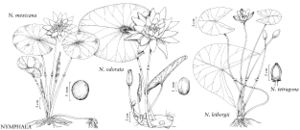Difference between revisions of "Nymphaea odorata"
Hort. Kew. 2: 227. 1789.
imported>Volume Importer |
RevisionBot (talk | contribs) m (Bot: Adding category Revision Pending) |
||
| Line 69: | Line 69: | ||
}}<!-- | }}<!-- | ||
| − | -->[[Category:Treatment]][[Category:Nymphaea]] | + | --> |
| + | |||
| + | [[Category:Treatment]] | ||
| + | [[Category:Nymphaea]] | ||
| + | [[Category:Revision Pending]] | ||
Revision as of 22:07, 13 August 2020
Rhizomes frequently branched, repent, cylindric; stolons absent. Leaves: petiole glabrous or pubescent. Leaf blade abaxially green to purple, adaxially green, ovate to nearly orbiculate, (5-)10-40 × (5-)10-40 cm, margins entire; venation radiate centrally, without weblike pattern, principal veins 6-27; surfaces glabrous. Flowers floating, 6-19 cm diam., opening and closing diurnally, only sepals and outermost petals in distinct whorls of 4; sepals uniformly green or reddened, obscurely to prominently veined, lines of insertion on receptacle not prominent; petals (14-)17-43, white, rarely pink; stamens 35-120, yellow, connective appendage projecting less than 1(-2) mm beyond anther; filaments widest below middle, mostly longer than anthers; pistil 10-25-locular, appendages at margin of stigmatic disk linear-tapered, 3-8(-10) mm. Seeds ovoid, ca. 1.5-4.5 × 0.9-3 mm, 1.5-1.75 times as long as broad, lacking papillae on surface.
Distribution
B.C., Man., N.B., N.S., Nfld. and Labr. (Nfld.), Ont., P.E.I., Que., Sask., Ala., Ariz., Ark., Calif., Colo., Conn., D.C., Del., Fla., Ga., Idaho, Ill., Ind., Iowa, Kans., Ky., La., Maine, Mass., Md., Mich., Minn., Miss., Mo., Mont., N.C., N.H., N.J., N.Mex., N.Y., Nebr., Nev., Ohio, Okla., Oreg., Pa., R.I., S.C., Tenn., Tex., Utah, Va., Vt., W.Va., Wash., Wis., Mexico, West Indies, Central America.
Discussion
Subspecies 2 (2 in the flora).
Nymphaea odorata is a polymorphic species, particularly in and around the Great Lakes region. Over much of that area the two entities treated here as subspecies are allopatric and can be readily distinguished; however, in areas of sympatry some populations are intermediate or contain some intermediate plants without any apparent loss of fertility. Although traditional treatments distinguish the two at specific rank, recent floristic works have accepted only one variable species with no infraspecific taxa. While calling attention to this taxonomic problem, field studies from within the Great Lakes region have not sufficiently accounted for the observed variation. Although evidence (P. H. Monson 1960; G. R. Williams 1970; I. L. Bayly and K. Jongejan 1982) suggests that some variability may be induced by environmental conditions, both extremes have been found growing together under seemingly identical conditions. Further study, especially involving artificial hybridization and/or molecular approaches, should be undertaken to clarify the relationship.
The geographic patterning of the overall variation and usefulness of retaining a separate status for those morphs previously classified as Nymphaea tuberosa justify the recognition of two subspecies at this time. The key, while useful in separating the two extremes in this morphologic continuum, is of limited use in identifying intermediate plants. Compounding the problem of identification is the fact that key characters are often poorly represented on herbarium material, thus some guidance should be taken from the distributional notes provided with each subspecies. Truly intermediate plants, known in Minnesota, Wisconsin, Michigan, New York, and Vermont, and in southern Ontario and Quebec, may be treated as N. odorata without regard to subspecies. Sporadic populations, most probably introduced, on the Great Plains and farther west are difficult to place to subspecies and are best treated similarly although they are here included under subsp. odorata.
Selected References
None.
Key
| 1 | Petiole not striped, rarely faintly striped; leaf blade abaxially usually reddish purple, occasionally green; seeds 1.5-2.5 mm. | Nymphaea odorata subsp. odorata |
| 1 | Petiole with brown-purple stripes; leaf blade abaxially green or faintly purple; seeds mostly 2.8-4.5 mm. | Nymphaea odorata subsp. tuberosa |
